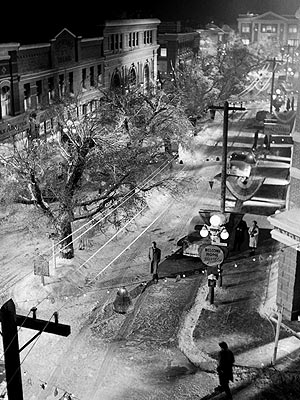
Damon Winter/The New York Times
Vegetable vendors worked recently amid rubble in Port-au-Prince, three years after an earthquake devastated the city. More Photos »
PORT-AU-PRINCE, Haiti — A few days after the Jan. 12, 2010, earthquake, Reginald Boulos opened the gates of his destroyed car dealership to some 14,000 displaced people who settled on the expansive property. Seven months later, eager to rebuild his business, he paid the families $400 each to leave Camp Boulos and return to their devastated neighborhoods.
At the time, Dr. Boulos, a physician and business magnate, was much maligned for what was portrayed as bribing the homeless to participate in their own eviction. But eventually, desperate to rid public plazas of squalid camps, the Haitian government and the international authorities adopted his approach themselves: “return cash grants” have become the primary resettlement tool.
This represents a marked deflation of the lofty ambitions that followed the disaster, when the world aspired not only to repair Haiti but to remake it completely. The new pragmatism signals an acknowledgment that despite billions of dollars spent — and billions more allocated for Haiti but unspent — rebuilding has barely begun and 357,785 Haitians still languish in 496 tent camps.
“When you look at things, you say, ‘Hell, almost three years later, where is the reconstruction?’ ” said Michèle Pierre-Louis, a former prime minister of Haiti. “If you ask what went right and what went wrong, the answer is, most everything went wrong. There needs to be some accountability for all that money.”
An analysis of all that money — at least $7.5 billion disbursed so far — helps explain why such a seeming bounty is not more palpable here in the eviscerated capital city, where the world’s chief accomplishment is to have finally cleared away most of the rubble.
More than half of the money has gone to relief aid, which saves lives and alleviates misery but carries high costs and leaves no permanent footprint — tents shred; emergency food and water gets consumed; short-term jobs expire; transitional shelters, clinics and schools are not built to last.
Of the rest, only a portion went to earthquake reconstruction strictly defined. Instead, much of the so-called recovery aid was devoted to costly current programs, like highway building and H.I.V. prevention, and to new projects far outside the disaster zone, like an industrial park in the north and a teaching hospital in the central plateau.
Meanwhile, just a sliver of the total disbursement — $215 million — has been allocated to the most obvious and pressing need: safe, permanent housing. By comparison, an estimated minimum of $1.2 billion has been eaten up by short-term solutions — the tent camps, temporary shelters and cash grants that pay a year’s rent.
“Housing is difficult and messy, and donors have shied away from it,” said Josef Leitmann, manager of the Haiti Reconstruction Fund.
Benefactors and Dysfunction
Beyond the numbers, the sluggish reconstruction has been the latest dispiriting chapter in the chronically dysfunctional relationship between Haiti and its benefactors.
After the earthquake, with good will and money pouring into Haiti, international officials were determined to use the disaster as a catalyst for transforming not only the intractably poor country but the world’s ineffectual strategies for helping it.
Bill Clinton, the United Nations special envoy for Haiti, invoked the “build back better” mantra he had imported from his similar role in South Asia after the tsunami. And Secretary of State Hillary Rodham Clinton cautioned donors to stop working around the government and instead work with it, and to stop financing “a scattered array of well-meaning projects” rather than making “deeper, long-term investments.”
But an examination by The New York Times shows that such post-disaster idealism came to be undercut by the enormousness of the task, the weakness and volatility of the Haitian government, the continuation of aid business as usual and the limited effectiveness of the now-defunct recovery commission that had Mr. Clinton as co-chairman.
This article has been revised to reflect the following correction:
Correction: December 24, 2012
An earlier version of this article misstated the date of the earthquake. It was on Jan. 12, 2010, not Jan. 10.












